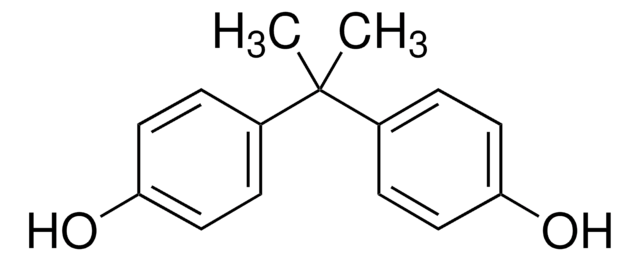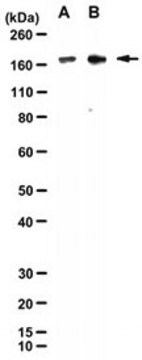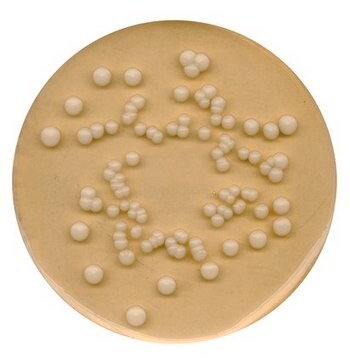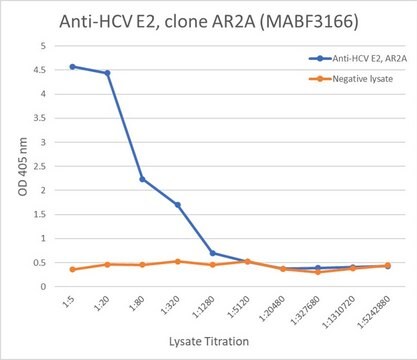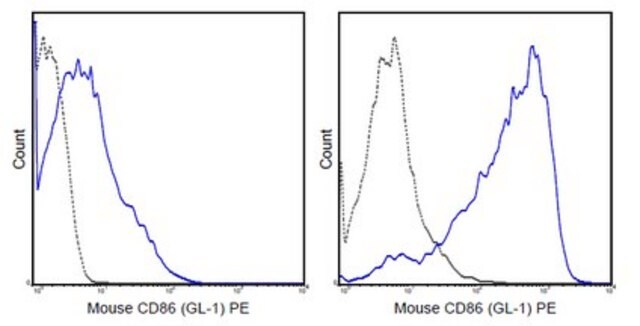MABF2820
Anti-HCV E2 Antibody, clone AP33
Synonym(e):
HCV envelope glycoprotein E2
About This Item
Empfohlene Produkte
Biologische Quelle
mouse
Qualitätsniveau
Antikörperform
purified antibody
Antikörper-Produkttyp
primary antibodies
Klon
AP33, monoclonal
Mol-Gew.
observed mol wt ~60 kDa
Aufgereinigt durch
using protein G
Speziesreaktivität
virus
Verpackung
antibody small pack of 100 μg
Methode(n)
ELISA: suitable
electron microscopy: suitable
immunoprecipitation (IP): suitable
inhibition assay: suitable
neutralization: suitable
western blot: suitable
Isotyp
IgG1κ
Epitopsequenz
N-terminal half
Protein-ID-Hinterlegungsnummer
UniProt-Hinterlegungsnummer
Lagertemp.
-10 to -25°C
Posttranslationale Modifikation Target
unmodified
Angaben zum Gen
vaccinia virus ... E2(684)
Allgemeine Beschreibung
Spezifität
Immunogen
Anwendung
Evaluated by Western Blotting in lysate from HEK293T cells transfected with a plasmid expressing the HCV E1 and E2 glycoproteins.
Western Blotting Analysis: A 1:1,000 dilution of this antibody detected HCV E2 in lysate from HEK293T cells transfected with a plasmid expressing the HCV E1 and E2 glycoproteins, but not in lysates from untransfected cells.
Tested Applications
Inhibition: A representative lot Inhibited the interaction of virus-like particles (VLPs) with CD81 and inhibited infection by HCVpp of diverse genotypes.(Owsianka, A., et al. (2001). J Gen Virol. 82(Pt8):1877-1883; Owsianka, A., et al. (2005). J Virol. 79(17):11095-104).
ELISA: A representative lot detected HCV E2 in ELISA application. (Owsianka, A., et al. (2005). J Virol. 79(17):11095-104; Rychlowska, M., et al. (2011). J Gen Virol. 92(Pt10)2249-2261; Vasiliauskaite, I., et al. (2017). mBio. 8(3):e00382-17).
Electron Microscopy: A representative lot detected virus like particles of HCV in Electron Cryomicroscopy application (Owsianka, A., et al. (2001). J Gen Virol. 82(Pt8):1877-1883; Clayton, R.F., et al. (2002). J Virol. 76(15):7672-82).
Western Blotting Analysis: A representative lot detected HCV E2 in Western Blotting application (Clayton, R.F., et al. (2002). J Virol. 76(15):7672-82; Rychlowska, M., et al. (2011). J Gen Virol. 92(Pt10)2249-2261; Hu, Z., et al. (2020). Cell Chem Biol. 27(7):780-792.e5).
Immunoprecipitation Analysis: A representative lot immunoprecipitated HCV E2 in Immunoprecipitation application (Owsianka, A., et al. (2005). J Virol. 79(17):11095-104).
Neutralizing: A representative lot neutralized HCV infection across all major genotypes of HCV (Owsianka, A., et al. (2005). J Virol. 79(17):11095-104; Potter, J.A., et al. (2012). J Virol. 86(23):12923-32).
Note: Actual optimal working dilutions must be determined by end user as specimens, and experimental conditions may vary with the end user.
Physikalische Form
Rekonstituierung
Lagerung und Haltbarkeit
Sonstige Hinweise
Haftungsausschluss
Sie haben nicht das passende Produkt gefunden?
Probieren Sie unser Produkt-Auswahlhilfe. aus.
Lagerklassenschlüssel
12 - Non Combustible Liquids
WGK
WGK 2
Flammpunkt (°F)
Not applicable
Flammpunkt (°C)
Not applicable
Analysenzertifikate (COA)
Suchen Sie nach Analysenzertifikate (COA), indem Sie die Lot-/Chargennummer des Produkts eingeben. Lot- und Chargennummern sind auf dem Produktetikett hinter den Wörtern ‘Lot’ oder ‘Batch’ (Lot oder Charge) zu finden.
Besitzen Sie dieses Produkt bereits?
In der Dokumentenbibliothek finden Sie die Dokumentation zu den Produkten, die Sie kürzlich erworben haben.
Unser Team von Wissenschaftlern verfügt über Erfahrung in allen Forschungsbereichen einschließlich Life Science, Materialwissenschaften, chemischer Synthese, Chromatographie, Analytik und vielen mehr..
Setzen Sie sich mit dem technischen Dienst in Verbindung.
